 The Mummy of Mayfair (An Irregular Detective Mystery #2) by Jeri Westerson
The Mummy of Mayfair (An Irregular Detective Mystery #2) by Jeri Westerson Format: eARC
Source: supplied by publisher via NetGalley
Formats available: hardcover, ebook
Genres: historical fiction, historical mystery, mystery
Series: Irregular Detective #2
Pages: 224
Published by Severn House on July 2, 2024
Purchasing Info: Author's Website, Publisher's Website, Amazon, Barnes & Noble, Kobo, Bookshop.org, Better World Books
Goodreads
Private investigators Timothy Badger and Benjamin Watson take on another unusual and baffling case in Victorian London when a mummy unwrapping party takes a chilling turn.London, 1895. Although their last high profile case was a huge success, private detectives Tim Badger and Benjamin Watson know they can't afford to turn down any work, despite financial assistance from their mentor, Sherlock Holmes.So when the eminent Doctor Enock Sawyer of St Bart's Hospital asks Badger if the duo will provide security for a mummy unwrapping party he is hosting, Badger doesn't hesitate to take the job. After all, how hard can guarding the doctor's bizarre Egyptian artefacts be? But with Doctor Sawyer running late for his own party, the 'genuine' ancient sarcophagus of Runihura Saa is unravelled to reveal the remains of . . . Doctor Sawyer! Suddenly, the pair are drawn into a new case that's stranger and twister than they could ever have imagined.
My Review:
The “irregularity” of the Irregular Detective series is in the person of one of its protagonists, Timothy Badger of the Badger and Watson Detecting Agency. Once upon a time, Badger was one of the “invisible” children who operated as Sherlock Holmes’ eyes and ears on the streets of Victorian London. In other words, Tim Badger was one of Holmes’ Baker Street Irregulars.
But when Badger aged out – or grew up – out of the Irregulars, he still needed to make his living. Which is where his partner, jack-of-all-trades Benjamin Watson comes into the picture. Both from the “wrong side of the tracks” in the East End, without a shilling between them, they set up as private detectives in the mode of Badger’s former ‘Guv’, the Great Detective himself.
As seen in the first entry in this series, The Isolated Séance, after five years of struggle to keep body and soul together, Sherlock Holmes himself gave these ‘apprentices’ a bit of a leg up. Their perseverance was rewarded with rooms in Soho – several steps up the economic ladder from their previous lodgings and office – and a seemingly magical refilling box of money for expenses.
They’re doing well for themselves. It’s a lot of hard work and shoe leather – but their successes seem to outnumber their failures. They have as much work as they can handle – and even their own chronicler in the person of newspaper reporter Ellsie Littleton.
Which leads to this second sensational case, The Mummy of Mayfair. A moniker that seems ripped, not from the headlines, but from the titles of the penny dreadful fiction that Badger loves to read. Watson prefers the newspapers and scientific journals.
After all, someone in this partnership needs to keep their feet on the ground, especially with a case that has so much potential to ascend – or perhaps that’s descend – into flights of fantasy and mythology.
It begins with a mummy unwrapping party. An all too common event among the upper crust in the 1890s. It was the heyday of ‘Egyptomania’, with all of the implications of madness the word mania implies.
Badger and Watson were hired by Dr. Enoch Sawyer to provide security for his mummy unwrapping party. A party that takes an even more macabre turn when the mummy is finally unwrapped to reveal that it’s not the mummy of Runihura Saa. It’s the much more recent mummy of Dr. Enoch Sawyer – their client – who is clearly not going to be able to pay them for the job they are about to do on his behalf.
And the game is afoot!
Escape Rating A-: First, I loved this every bit as much as the first book in this series, The Isolated Séance. Second, I need to kick myself for not figuring out that the series title is a pun until now. I sorta/kinda thought the cases were “irregular” and they are that – from a séance in the first book to a mummy in the second. But it’s the DETECTIVES – or at least one of them – that are irregular. As in, the Baker Street Irregulars. 🤦🏻
Now that I’ve got that out of my system, what makes this case so much fun is the way that it blends the real with the fictional.
Mummy unwrapping parties were a very real thing in the 1890s – as shown in the painting below by artist Paul Dominique Philippoteaux circa 1890. The scene may seem macabre to 21st century readers, but such parties were all the rage in 1895, when The Mummy of Mayfair takes place.

Rage also being an important factor – at least in this particular case – as the ‘mania’ led people to strange rivalries and illegal behaviors – as humans are wont to do in the throes of a craze, fad, or mania. It still happens now, and humans haven’t changed all that much in just a bit over a century.
As much as the insanity of this particular mania turns out to be the impetus for the actions of the characters, what is making the series work are the characters and the way they manage to fit into – and take off from – the canon of Sherlock Holmes and ITS well-known and loved protagonists.
The best detectives, whether amateur or professional, are outsiders. It’s nearly impossible for humans to set aside their preconceived notions and biases in regards to people they know. A fact which very nearly sends the entire case on a wild goose chase, as one of the possible suspects is one of Badger’s former colleagues in the Irregulars.
But the triumvirate necessary to fill all of the roles that in the original canon were filled by just two changes the structure of the investigation even as it challenges the reader to see Holmes’ Victorian age from a considerably less lofty perspective.
Timothy Badger grew up in the East End, living by his wits and the nimbleness of his fingers. His accent clearly marks him as being of a “lower class” to the toffs among whom he now finds himself – and he has to grow into his role without giving up who he essentially is.
Benjamin Watson is a black man in a white world. The first thing that anyone sees when they meet him is the color of his skin. He has the intelligence and the drive to have been anything within his reach, but his reach in the late Victorian era is circumscribed by his race.
Miss Ellsie Moira Littleton is a woman in a man’s world. Much like Charlotte Sloane in the Regency-set Wrexford and Sloane series, Ellsie has been forced by circumstances to be self-supporting, and is on the outside of the society to which she was born. As an intelligent, educated, woman who needs to make her own way, she is also an outsider but with an entirely different perspective on the society of which she was once a member.
From its sensational beginning, the case is a deeply puzzling mess. Badger and Watson’s preconceived notions about their clients and their former associates, as well as their lack of knowledge of the precise ways the rich spend their time and money and protect their positions frequently send them haring off in the wrong directions – and we follow them eagerly even as they frequently caution each other.
As I’ve said frequently within these pages, I’m a sucker for Sherlock Holmes pastiches, and that’s why I initially started this series. Now I’m hooked! I’m really looking forward to the next book in this series, The Misplaced Physician, where we’ll finally get to meet Sherlock Holmes’ Watson, as Badger and his Watson will be on the case of rescuing him! It’s a good thing that investigative reporter Ellsie Littleton will be on hand to record the adventure, as the original Watson may be too embarrassed – or too injured – to write it up himself.
We’ll certainly see, hopefully this time next year!

 The Most Human: Reconciling with My Father, Leonard Nimoy by
The Most Human: Reconciling with My Father, Leonard Nimoy by  Ghostdrift (Finder Chronicles #4) by
Ghostdrift (Finder Chronicles #4) by  Over the course of the series (
Over the course of the series ( Escape Rating A+: June is Audiobook Month, and this final book in the
Escape Rating A+: June is Audiobook Month, and this final book in the 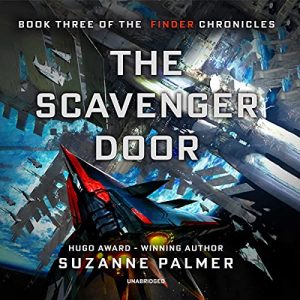 Together, those three plots, Belos’ need for closure, Captain Ahab – actually Captain Todd – following Belos where no one REALLY should have gone before, or again, and all the crews stuck on their very own tiny Gilligan’s Island planetoid, doing their best – or worst – to get along well enough to get back home.
Together, those three plots, Belos’ need for closure, Captain Ahab – actually Captain Todd – following Belos where no one REALLY should have gone before, or again, and all the crews stuck on their very own tiny Gilligan’s Island planetoid, doing their best – or worst – to get along well enough to get back home.
 We Speak Through the Mountain (Annual Migration of Clouds, #2) by
We Speak Through the Mountain (Annual Migration of Clouds, #2) by  Escape Rating B+: I had not read
Escape Rating B+: I had not read  The Bodies in the Library (First Edition Library Mystery, #1) by
The Bodies in the Library (First Edition Library Mystery, #1) by  The discovery of a body in the Society’s library, the morning after a contentious meeting of a local writers’ group, seems a bit too much like it’s straight out of the pages of one of the Agatha Christie novels sitting on a nearby shelf, The Body in the Library.
The discovery of a body in the Society’s library, the morning after a contentious meeting of a local writers’ group, seems a bit too much like it’s straight out of the pages of one of the Agatha Christie novels sitting on a nearby shelf, The Body in the Library. Speaking of media, however, the audio was fine, and it certainly got me over the rough first third of the book that drove me away the first time around. So I’m glad I picked it up – even though once the story finally got started I got more than caught up in it enough to want to find out whodunnit a whole lot faster than audio would allow.
Speaking of media, however, the audio was fine, and it certainly got me over the rough first third of the book that drove me away the first time around. So I’m glad I picked it up – even though once the story finally got started I got more than caught up in it enough to want to find out whodunnit a whole lot faster than audio would allow.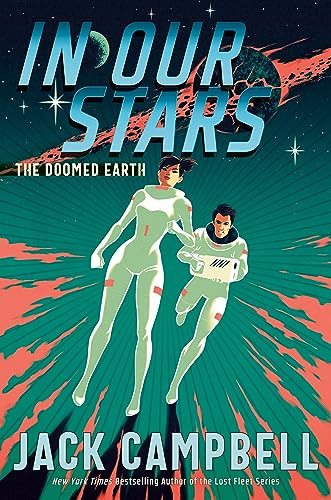 In Our Stars (The Doomed Earth, #1) by
In Our Stars (The Doomed Earth, #1) by 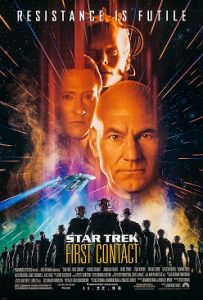 Escape Rating B: I couldn’t get the resemblance to Trek out of my head, and that affected my reading of this book a lot because it felt just a bit too familiar. To the point where even though I didn’t know what was coming, I sorta/kinda knew what was coming. Also, to the point where I couldn’t resist falling down a Trek time travel rabbit hole. Or should I say, a time travel black hole, because that device was used frequently and often, even if that’s not quite what happened here.
Escape Rating B: I couldn’t get the resemblance to Trek out of my head, and that affected my reading of this book a lot because it felt just a bit too familiar. To the point where even though I didn’t know what was coming, I sorta/kinda knew what was coming. Also, to the point where I couldn’t resist falling down a Trek time travel rabbit hole. Or should I say, a time travel black hole, because that device was used frequently and often, even if that’s not quite what happened here. Every Time We Say Goodbye (Jane Austen Society, #3) by
Every Time We Say Goodbye (Jane Austen Society, #3) by  I picked this up because I loved the author’s earlier book,
I picked this up because I loved the author’s earlier book,  Escape Rating B: Before I get to the story of the book, I absolutely need to say something about the audiobook. Specifically, that the audiobook is excellent. The reader, Juliet Aubrey, was a perfect choice and she made the whole thing better and carried me through even at points where I wondered how the parts of the story connected to each other because she was just awesome.
Escape Rating B: Before I get to the story of the book, I absolutely need to say something about the audiobook. Specifically, that the audiobook is excellent. The reader, Juliet Aubrey, was a perfect choice and she made the whole thing better and carried me through even at points where I wondered how the parts of the story connected to each other because she was just awesome. .
.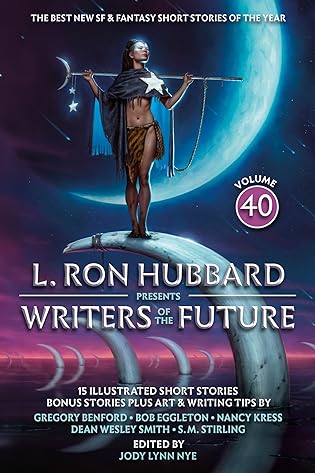 L. Ron Hubbard Presents: Writers of the Future, Volume 40 by
L. Ron Hubbard Presents: Writers of the Future, Volume 40 by 
 Funny Story by
Funny Story by  Escape Rating A: I started out listening to this one, and that’s probably what got me over the hump of the early chapters. This is one of those stories that, of necessity, has a very hard start. We meet Daphne just after very nearly the entire life she had planned crashed and burned. She’s wallowing in a whole lot of angst and regret and self-recrimination, nearly buried by the weight of her emotional baggage piling up all around her. Listening to the excellent narrator makes the listener feel like they are literally inside Daphne’s mostly despairing head and it’s a realistically well-portrayed terrible place to be.
Escape Rating A: I started out listening to this one, and that’s probably what got me over the hump of the early chapters. This is one of those stories that, of necessity, has a very hard start. We meet Daphne just after very nearly the entire life she had planned crashed and burned. She’s wallowing in a whole lot of angst and regret and self-recrimination, nearly buried by the weight of her emotional baggage piling up all around her. Listening to the excellent narrator makes the listener feel like they are literally inside Daphne’s mostly despairing head and it’s a realistically well-portrayed terrible place to be. That Peter ultimately gets the shaft all the way around turned out to be merely the icing on a very tasty cake of a book – or perhaps that should be the slathering of cheese and jalapenos on a fresh, hot serving of Petoskey fries. The part that makes a good thing just that much better.
That Peter ultimately gets the shaft all the way around turned out to be merely the icing on a very tasty cake of a book – or perhaps that should be the slathering of cheese and jalapenos on a fresh, hot serving of Petoskey fries. The part that makes a good thing just that much better.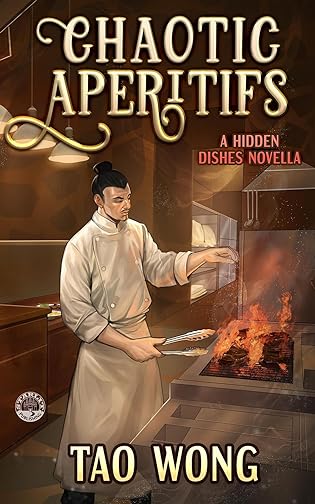 Chaotic Apéritifs: A Cozy Cooking Fantasy (Hidden Dishes Book 2) by
Chaotic Apéritifs: A Cozy Cooking Fantasy (Hidden Dishes Book 2) by 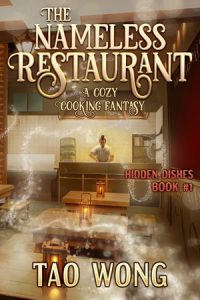 Escape Rating A-: I’m doing this review a week early so that you have a chance to read the tasty first book in the
Escape Rating A-: I’m doing this review a week early so that you have a chance to read the tasty first book in the